There’s a new dog breed on the block that has everyone asking, “What’s a Black Labradoodle?” This week, we’re giving you the complete guide to everything there is to know about this hybrid pup. From their temperament and personality to their exercise needs and grooming tips, we’ve got it all!
So if you’re considering adding a Black Labradoodle to your family, read on for all the info you need. You might just find out that this pooch is perfect for you!
Black Labradoodle Overview
| Attribute | Description |
|---|---|
| Breed | Black Labradoodle (crossbreed between Black Labrador retriever and Poodle) |
| Personality | Intelligent, friendly |
| Coat | Hypoallergenic |
| Suitable as a pet | Excellent family dog, great for people with allergies |
| Exercise needs | Moderate |
| Mental stimulation | Benefits from plenty of mental stimulation |
| Grooming requirements | Weekly brushing and occasional trimming/clipping |
| Average weight | 40-70 pounds |
| Average lifespan | 10-12 years |
| Cost | $600-$3000 (varies depending on the breeder) |
What’s a Black Labradoodle?
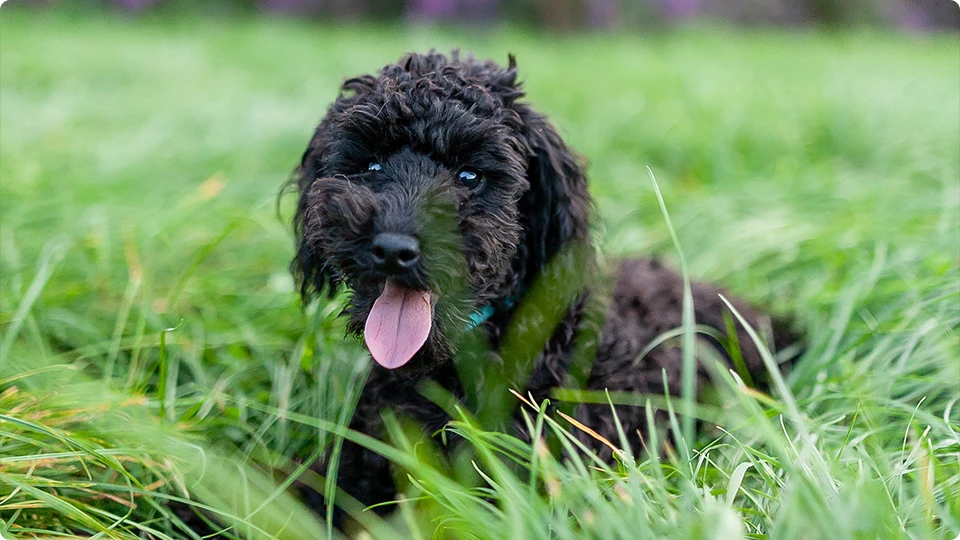
A Black Labradoodle is a cross between a Labrador Retriever and a Standard Poodle. These pups are relatively new to the scene, but they’ve already become quite popular thanks to their amazing personalities and great looks.
While every Black Labradoodle is unique, they typically inherit some of the best qualities from both of their parent breeds. That means they’re usually intelligent, friendly, and easy to train. They also tend to be low-shedding, making them a good choice for people with allergies. Plus, those black curls are just too cute!
Origin of the Black Labradoodle
The Black Labradoodle breed was first created in Australia in the 1980s. The original purpose of this cross was to create a hypoallergenic guide dog for people with allergies. And since black is one of the most popular Doodle colors, it’s no surprise that this is the shade that has taken off in recent years.
Today, Black Labradoodles can be found all over the world. And whether you’re looking for a family pet or a companion for your allergies, one of these pups might just be the perfect fit!
Origins of the Poodle
The Poodle is a German breed that was originally bred as a working dog. They were used for tasks like hunting and retrieving, and they quickly became known for their intelligence and trainability. Standard Poodles were the largest of the three Poodle varieties (Standard Poodle, Miniature Poodle, Toy Poodle), and they were the ones used in the Labradoodle cross.
Origins of the Labrador Retriever
Labrador Retrievers are one of the most popular dog breeds in the world, and it’s no surprise why. These pups are known for their friendly, outgoing personalities and their love of family.
Labs were originally bred in Newfoundland to help fishermen with tasks like hauling in nets and fetching fish that had fallen overboard. But it wasn’t long before they became popular companions and working dogs in their own right.
Today, Labs are used as service dogs, therapy dogs, and of course, beloved family pets.
Size and Appearance of the Black Labradoodle
Black Labradoodles can range in size from miniature to giant, depending on the size of their parents. They typically weigh between 50 and 65 pounds and stand 18 to 24 inches tall at the shoulder.
As for their black coat, it can be either straight or curly, and may be medium or long in length. Some Black Labradoodles even have a few white markings on their chest or paws.
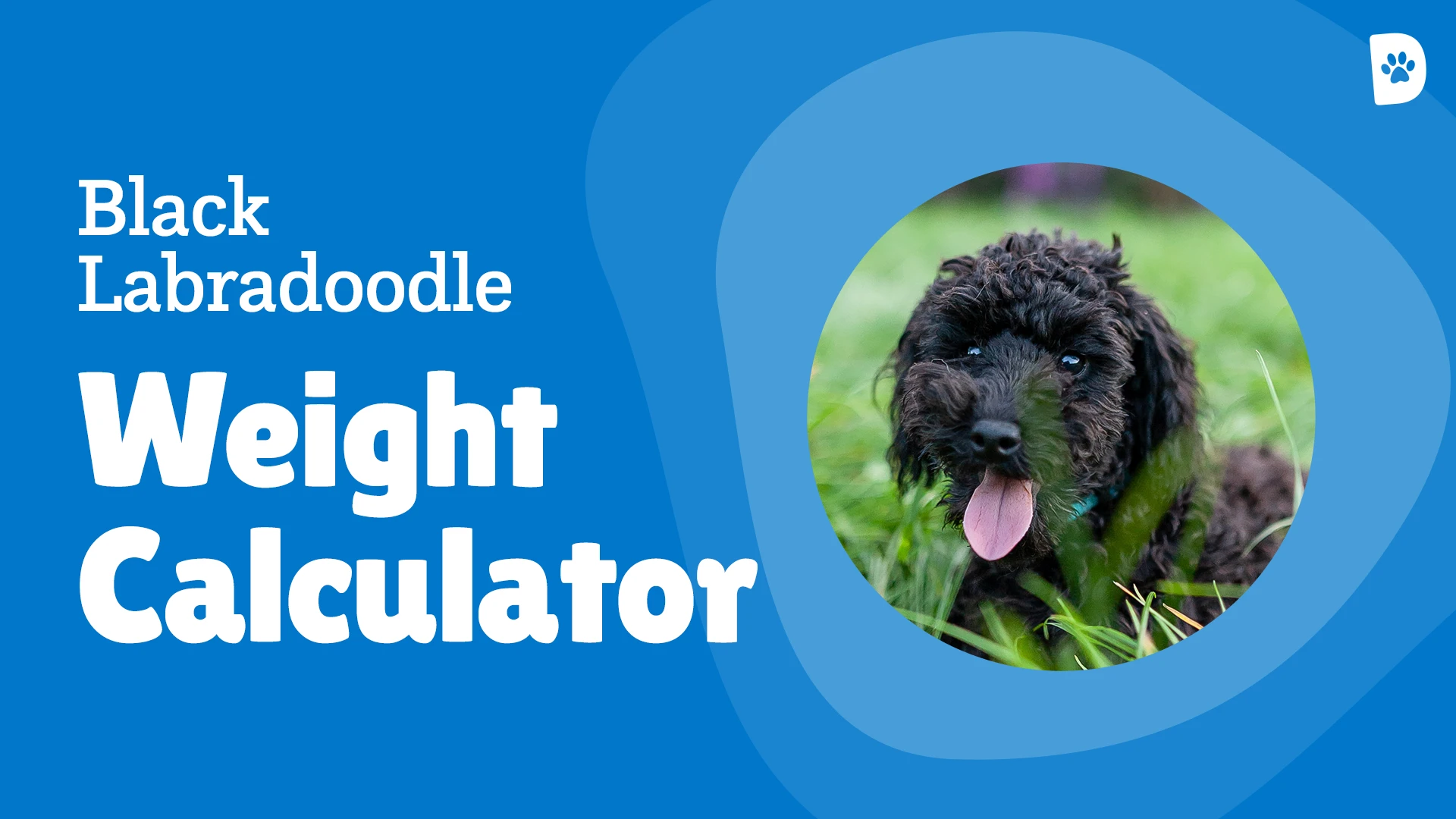
Note: This is just a rough estimate and the actual weight of a dog can vary based on various factors such as breed, genetics, and overall health.
Black Labradoodle Weight Tool
Enter the Age of the Dog (in months):
Estimated Weight (in pounds):
Black Labradoodle Size and Types
When it comes to size, Black Labradoodles can range from miniature to giant, depending on the size of their parents.
But if you’re looking for a smaller black Doodle, you might want to consider a Miniature Black Labradoodle, a Medium Black Labradoodle, or Toy Black Labradoodle. These pups usually weigh between 15 and 35 pounds and stand 10 to 15 inches tall at the shoulder.
Size of Black Labradoodle puppies
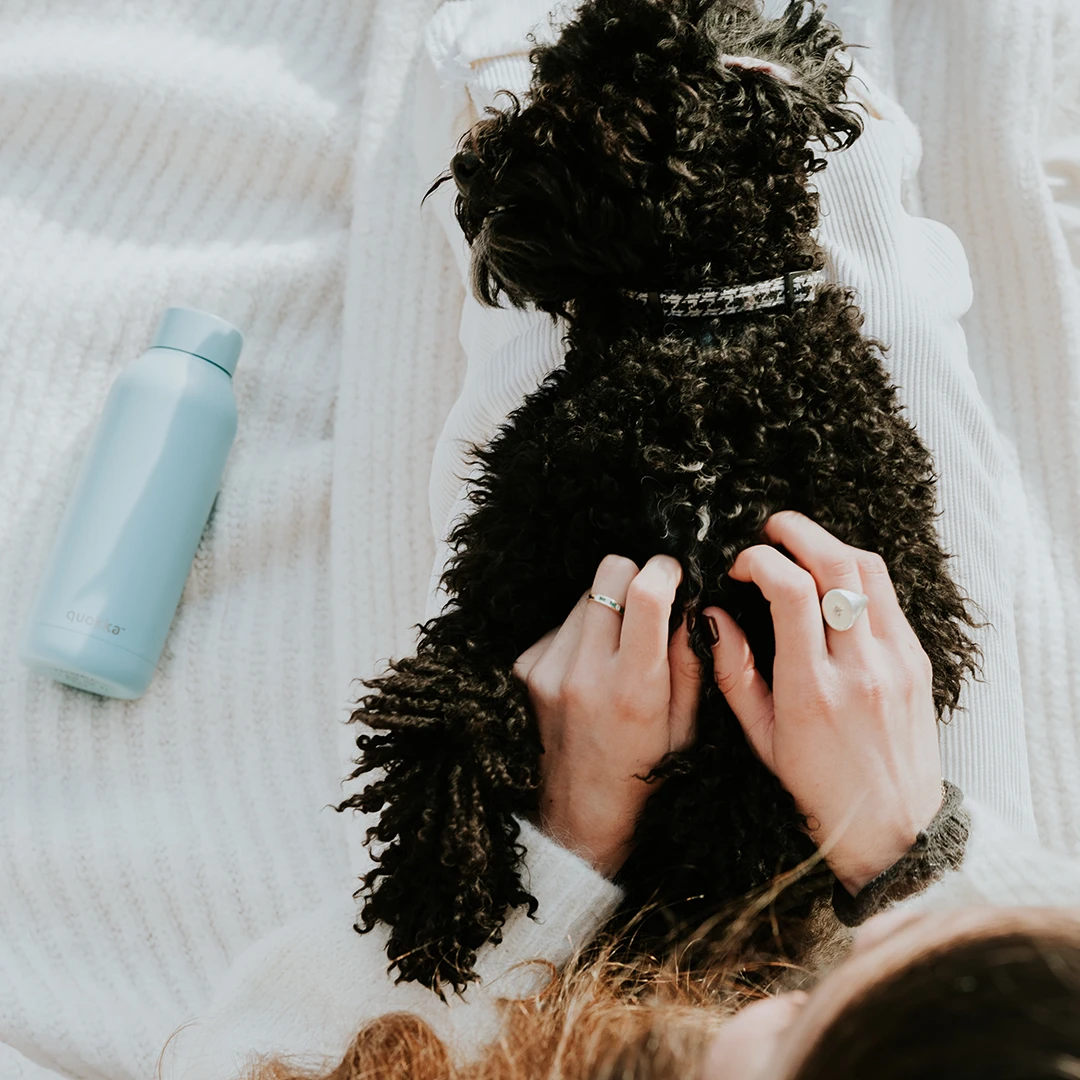
When Black Labradoodle puppies are born, they typically weigh between 8 and 10 ounces. They will gain about 5 pounds per week for the first few weeks of life. At 6 weeks old, Black Labradoodle puppies will be ready to leave their mother and go to their forever homes.
When is a Black Labradoodle Full Grown?
Black Labradoodles are usually full-grown by the time they are 18 to 24 months old. However, some may continue to fill out and mature until they are 3 years old.
Black Labradoodle Color Variations
As the name suggests, black is the most common color for this breed. However, you may also find Black Labradoodles with white markings on their chest or paws, which would be considered a black and white Labradoodle.
Black Labradoodle Coat Type
Black Labradoodles can have either a straight or curly coat, and it may be medium or long in length. The type of coat your Black Labradoodle has will depend on the type of coat their parents had.
Labradoodle coats can be classified into three categories: wool, fleece, or hair. Black Labradoodles with a wool coat will have tight, small curls that are similar to the Poodle’s coat. Fleece coats are soft, loose curls that are similar to a sheep’s fleece. And Black Labradoodles with a hair coat will have straight or wavy hair that is more like the Labrador Retriever’s coat.
No matter what type of coat your Black Labradoodle has, it will require regular grooming to prevent mats and tangles. Be sure to brush your Doodle’s coat at least once a week, and more often if it is long or curly. You should also take your Labradoodle Black to a professional groomer every few months for a bath, trim, and nail clip.
What is a F1b Black Labradoodle?
A F1b Black Labradoodle is a Black Labradoodle that is the result of breeding a Black Labradoodle back to a Poodle. This type of Labradoodle will have a higher percentage of Poodle in their pedigree, which means they are more likely to inherit the Poodle’s hypoallergenic coat.
What’s the difference between F1 and F1b?
The main difference between F1 and F1b Black Labradoodles is the percentage of Poodle in their pedigree. F1 Black Labradoodles are 50% Labrador Retriever and 50% Poodle, while F1b Black Labradoodles are 75% Poodle and 25% Labrador Retriever.
Black Labradoodles and Fading
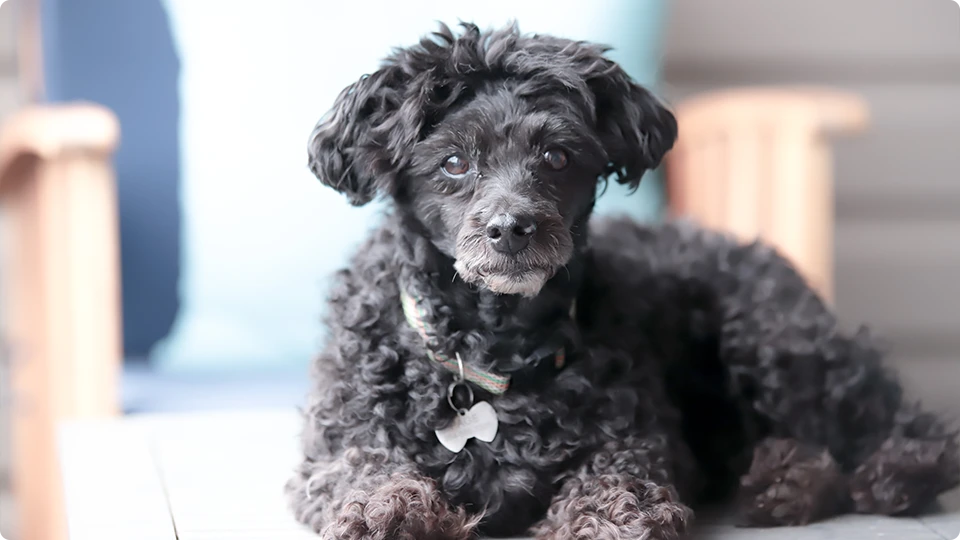
Some Black Labradoodles may experience coat fading, which is when the black color of their coat starts to lighten. This usually happens as the Doodle gets older and is exposed to more sunlight.
While coat fading is not harmful to your dog, some people prefer to avoid it by keeping their Doodle indoors or using sunscreen when they are outdoors.
Kemp hair
Some Black Labradoodles may have a condition called kemp hair, which is when straight hairs grow among the curly hairs of their coat. This can happen in any Doodle breed, but it is more common in Black Labradoodles.
Kemp hair is not harmful to your Black Labradoodle, but it can be difficult to manage. If you Black Labradoodle has kemp hair, you may need to brush their coat more often to prevent mats and tangles.
Dilute gene
The dilute gene is responsible for coat color in Black Labradoodles. This gene can cause the black color of their coat to fade or lighten over time. The dilute gene is also responsible for the blue and silver colors that some Black Labradoodles may have.
Health issues and fading coats
Many Black Labradoodles experience coat fading as they get older. This is usually due to a number of health problems, including hypothyroidism, liver problems, and kidney problems. While these health problems are not always fatal, they can cause the black color of a Black Labradoodle’s coat to lighten or even disappear completely.
Temperament and Personality of the Black Labradoodle
Black Labradoodles are known for being intelligent, friendly, and easy to train. They make great family pets and love spending time with people. They’re also very social creatures, so they do best in homes where someone is around most of the day.
Black Labradoodles need moderate exercise and benefit from plenty of mental stimulation. That means they’ll need a few short walks each day, along with some interactive toys and games to keep their minds active.
Do Black Labradoodles bark a lot?
Black Labradoodles are not known for being yappy dogs. However, all dogs bark from time to time, and Black Labradoodles are no exception.
If your dog is barking excessively, it could be a sign that they’re bored or anxious. Be sure to provide them with plenty of exercise and mental stimulation to help reduce their barking.
Do Black Labradoodles bite?
All dogs have the potential to bite, but Black Labradoodles are not known for being aggressive. If your dog does bite, it is likely due to fear or anxiety. Be sure to socialize and train your Black Labradoodle from a young age to help prevent this behavior.
Do Black Labradoodles do well with other dogs?
Yes, Black Labradoodles do well with other dogs. They are social creatures by nature and love being around people and other animals. Be sure to introduce your Black Labradoodle to other dogs gradually to ensure that everyone gets along.
Do Black Labradoodles like to swim?
Many Black Labradoodles enjoy swimming, but not all of them do. It really depends on the individual dog. Some Black Labradoodles take to water immediately, while others never seem to enjoy it.
If you’re not sure if your Black Labradoodle likes to swim, you can always take them to a local dog park and let them try it out for themselves.
Do Black Labradoodles like to cuddle?
Yes, Black Labradoodles love to cuddle! They are known for being affectionate and loving dogs. If you’re looking for a snuggle buddy, a Black Labradoodle would be a great choice.
Black Labradoodle Price
The Black Labradoodle price can vary depending on a number of factors, such as the breeder’s location, the dog’s parents’ pedigrees, and whether or not the Black Labradoodle has been spayed or neutered. In general, Black Labradoodles cost between $600 and $3000.
When does a Black Labradoodle Reach Sexual Maturity?
Black Labradoodles reach sexual maturity between 6 and 18 months of age.
Should I spay or neuter my Black Labradoodle?
There are pros and cons to spaying or neutering your Black Labradoodle. Ultimately, the decision is up to you and your veterinarian.
Some people choose to spay or neuter their Black Labradoodles because it can help reduce aggression and roaming behaviors. Additionally, spaying or neutering can help your Black Labradoodle live a longer and healthier life.
On the other hand, some people choose not to spay or neuter their Black Labradoodles because they want their dog to retain its natural instincts. Additionally, unspayed or unneutered Black Labradoodles may have a higher tendency to mark their territory.
When should I spay or neuter my Black Labradoodle?
If you do decide to spay or neuter your Black Labradoodle, the best time to do it is between 6 and 18 months of age.
Related: Spaying and Neutering: Everything You Need to Know
Training a Black Labradoodle
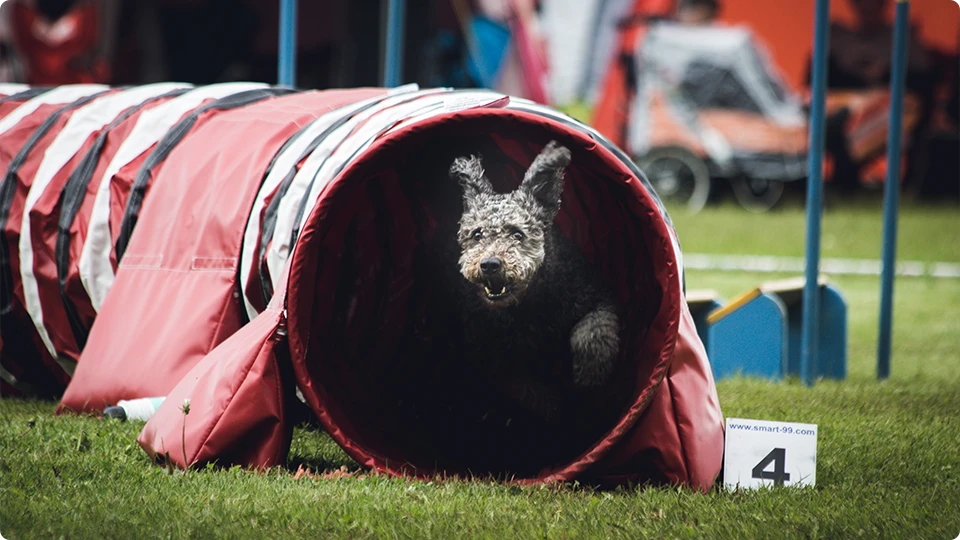
Black Labradoodles are intelligent dogs that love to please their owners. That makes them relatively easy to train. However, all dogs need patience and consistency during training. Be sure to use positive reinforcement techniques such as treats and praise to help your Black Labradoodle learn quickly.
Here are a few tips to help you train your Black Labradoodle:
- Start training early. The sooner you start, the better.
- Be consistent. Dogs thrive on consistency, so be sure to use the same commands, tone of voice, and body language each time you train.
- Use positive reinforcement. Rewards such as treats and praise are more effective than punishment when training a Black Labradoodle.
- Be patient. Training takes time and patience. Don’t get discouraged if your Black Labradoodle doesn’t seem to be progressing as quickly as you’d like. They’ll get there eventually with enough practice.
Exercise Needs of the Black Labradoodle
Black Labradoodles need moderate exercise and benefit from plenty of mental stimulation. That means they’ll need a few short walks each day, along with some interactive toys and games to keep their minds active. A Black Labradoodle that doesn’t get enough exercise may become bored or destructive. So if you’re considering one of these pups, be sure you have the time and energy to commit to their needs.
Some ideas for how to exercise your dog include:
- Take your dog for a walk.
- Play fetch with your dog.
- Take your dog to the park and let them run around.
- Go for a hike with your dog.
- Train your dog basic commands such as sit, stay, come, and down.
- Play tug of war with your dog.
- Teach your dog how to catch a ball.
- Have your dog do tricks like rolling over or playing dead.
- Buy some interactive toys like a Kong toy or a treat dispenser ball.
- Give your dog plenty of chew toys to keep them occupied.
Health Issues Common in Black Labradoodles
The Black Labradoodle is generally a healthy breed with few health concerns.
Dogs are susceptible to a variety of health issues, some more common than others. Below is a list of the five most common health issues that Black Labradoodles face:
- Hip dysplasia: A condition in which the hip joint is not properly formed, leading to pain and lameness.
- Elbow dysplasia: A condition in which the elbow joint is not properly formed, leading to pain and lameness.
- Von Willebrand’s disease: A bleeding disorder that affects dogs and humans.
- Bloat: A life-threatening condition in which the stomach expands due to gas or fluid accumulation.
- Cancer: The number one killer of dogs over age 10. There are many different types of cancer that can affect dogs.
While these health conditions are serious, they are also relatively rare. The Black Labradoodle is a generally healthy breed with a lifespan of 10-12 years.
To help ensure your Black Labradoodle stays healthy, be sure to take them to the vet for regular checkups and vaccinations. You should also feed them a high-quality diet and make sure they get plenty of exercise.
Black Labradoodles as Family Pets
Black Labradoodles make great family pets thanks to their friendly, easygoing nature. They’re also intelligent and easy to train, which makes them a good choice for first-time dog owners. Just be sure you’re prepared to meet their exercise and grooming needs.
If you think a Black Labradoodle is the right fit for your family, be sure to contact a reputable breeder today!
Grooming Your Black Labradoodle
Before adding a Black Labradoodle to your family, prepare for regular grooming. Brush them several times a week to prevent mats and tangles, and take them to a professional groomer every few months for a bath, trim, and nail clip.
Black Labradoodles are moderate shedders, so you may find some hair around the house. But if you’re allergic to dogs, they may be a good choice for you since they don’t shed as much as most breeds.
Common Black Labradoodle haircuts
- The short haircut is the most common Black labradoodle haircut. This style is easy to maintain and just requires a brush once a week.
- The long haircut is also popular among Black Labradoodles. This style requires more frequent brushing but also results in less shedding.
- The teddy bear cut is a shorter variation of the long haircut that’s popular among Black Labradoodles because it’s still easy to maintain and doesn’t require as much brushing.
- The puppy cut is a very short haircut that’s perfect for Black Labradoodles who are prone to mats and tangles. This style is also easy to maintain and only requires a brush once a week.
Related: Best Haircuts for Goldendoodles
How to brush your Black Labradoodle
- Start with a brush that has soft, flexible bristles.
- Brush in the direction of your Black Labradoodle’s hair growth to avoid irritating their skin.
- Pay special attention to areas where mats and tangles are likely to form, such as the base of the tail and behind the ears.
Detangler sprays and conditioners help to loosen stubborn mats and tangles. They work by coating the hair with a thin film that makes it easier to brush out. There are several different types of dog brushes available, each with its own set of benefits.
Bristle brushes are the most common type of brush and are ideal for general grooming. They have stiff bristles that help remove dirt, debris, and loose hair from the coat.
Slicker brushes have wire bristles that are bent at an angle. They’re used to detangle mats and remove dead hair from the coat.
Pin brushes have long, metal pins that penetrate the coat and remove dirt and debris. They’re ideal for thick-coated breeds such as Black Labradoodles.
Rake brushes have metal pins that are arranged in a fan-like pattern. They’re used to remove dead hair and mats from the coat.
How to brush your Black Labradoodle’s teeth
Brushing your Black Labradoodle’s teeth is important for their overall health. plaque and tartar can build up on their teeth and lead to gum disease. Start by getting your Black Labradoodle used to having you handle their mouth. Gently lift their lips and rub your fingers along their gums.
Once they’re comfortable with this, you can start brushing their teeth with a dog-specific toothbrush and toothpaste. Be sure to brush gently to avoid irritating their gums. You should brush your dog’s teeth at least once a week, but daily brushing is best.
If you’re not able to brush their teeth every day, give them dental chews or treats to help remove plaque and tartar. Dental chews are designed to be swallowed, so be sure to choose ones that are the right size for your Black Labradoodle.
How to bathe your Black Labradoodle
Black Labradoodles only need to be bathed every few months, but they may need more frequent baths if they get dirty or start to develop a doggy odor. When bathing your Black Labradoodle, be sure to use a dog-specific shampoo and conditioner. Human shampoo and conditioner can be too harsh for their skin and coat.
Start by wetting your Black Labradoodle’s coat with warm water. Apply the shampoo and work it into their coat, being careful to avoid their eyes and ears. Rinse the shampoo out with warm water and then apply the conditioner. Let it sit for a few minutes before rinsing it out.
After bathing your Black Labradoodle, be sure to dry their coat thoroughly. Wet dog hair can mats and tangles. You can either use a towel or a dog hair dryer set on the low or cool setting.
How to trim your Black Labradoodle’s nails
Trimming your Black Labradoodle’s nails is important for their overall health. If their nails get too long, they can start to curl under and grow into their paw pads. This can be painful and lead to infection.
Start by getting your Black Labradoodle used to having you handle their feet. Gently lift each paw and rub your fingers along the pads. Once they’re comfortable with this, you can start trimming their nails.
Use a dog-specific nail trimmer or clipper and trim the nails just above the quick. The quick is the blood vessel in the nail that supplies blood to the nail. If you cut into the quick, it will be painful for your Black Labradoodle and can cause bleeding.
If you’re not comfortable trimming your Black Labradoodle’s nails, take them to a groomer or veterinarian. They can trim the nails for you.
How to clean your Black Labradoodle’s ears
Cleaning your Black Labradoodle’s ears is important for their overall health. Ear infections are common in dogs and can be painful. Start by getting your Black Labradoodle used to having you handle their ears. Gently lift their ears and rub your fingers along the inside.
Once they’re comfortable with this, you can start cleaning their ears. Use a dog-specific ear cleaner and apply it to a cotton ball. Gently wipe the inside of their ears, being careful not to insert the cotton ball into their ear canal. You should clean your Black Labradoodle’s ears once a week.
If you notice your Black Labradoodle scratching their ears or shaking their head, this may be a sign of an ear infection.
Take the Black Labradoodle to the veterinarian for treatment.
Pros of a Black Labradoodle
There are many pros to owning a Black Labradoodle:
- They’re a great family dog.
- They’re loyal and protective.
- They’re always happy to see you.
- They’re good with kids and other pets.
- They have a wagging tail and lovable personality.
- They’re easy to train and respond well to positive reinforcement techniques.
- They love going for walks and playing fetch in the park or yard.
- Black Labradoodles are intelligent and can easily learn new commands or tricks, making them fun to train.
- Black Labradoodles are low-maintenance dogs that don’t need frequent grooming, bathing, or trimming of their nails.
- Black Labradoodles make excellent service dogs due to their friendly temperament, intelligence, and willingness to please their owners.
Cons of a Black Labradoodle
There are a few cons to owning a Black Labradoodle:
- They’re a high-energy dog and need plenty of exercise. If they don’t get enough, they may become destructive.
- They can be a shedding breed and may not be suitable for people with allergies.
- Socialize them from a young age or they may develop fear or aggression towards new people and other dogs.
- They’re a black-colored dog, so they may attract more ticks and fleas than other dogs.
- They’re a mix of two popular breeds, so they may be expensive to purchase from a breeder.
Should I get a Black Labradoodle?
A Black Labradoodle may be a good fit for you if:
- You’re looking for a loyal and loving family dog.
- You have the time and energy to walk or run with them every day.
- You don’t mind some shedding in your home.
- You’re willing to socialize them from a young age.
- You don’t mind spending a bit more on their purchase price.
How to find a Black Labradoodle Puppy
If you’ve decided a Black Labradoodle is the right dog for you, there are a few things to keep in mind when searching for a reputable Black labradoodle breeder:
- Ask your veterinarian or local animal shelter for recommendations.
- Do your research and visit several breeders before making a decision.
- Meet the parents of the Black Labradoodle puppy you’re interested in to get an idea of their temperament.
- Make sure the breeder can provide health clearances for the parents.
- Ask to see the puppy’s health records, including vaccinations and deworming schedule.
Related: The Ultimate Labradoodle Puppy Guide
Where to find Black Labradoodle puppies for sale?
There are a few different places you can look for Black Labradoodle puppies for sale. You can search online, or contact a local breeder. You can also check with your local animal shelter or rescue group, as they may have Black Labradoodles available for adoption.
Puppy-proofing your home
Once you’ve brought your Black Labradoodle puppy home, there are a few things you’ll need to do to puppy-proof your home:
- Keep them away from small items that they could choke on, such as toys, coins, and paper clips.
- Put away any toxic chemicals or cleaners.
- Block off any stairs or areas with steep drop-offs.
- Remove anything they could chew on, such as electrical cords, shoes, and furniture.
- Give them their own space to sleep, eat, and play in.
Conclusion
A Black Labradoodle can make a great addition to your family. They’re loyal, loving, and low-maintenance dogs that are easy to train. However, they’re also high-energy dogs that need plenty of exercise. Make sure you’re ready to meet the needs of a Black Labradoodle before getting one. Once you bring them home, be sure to puppy-proof your home and socialize them from a young age. With the proper care, a Black Labradoodle can be a great companion for many years to come.